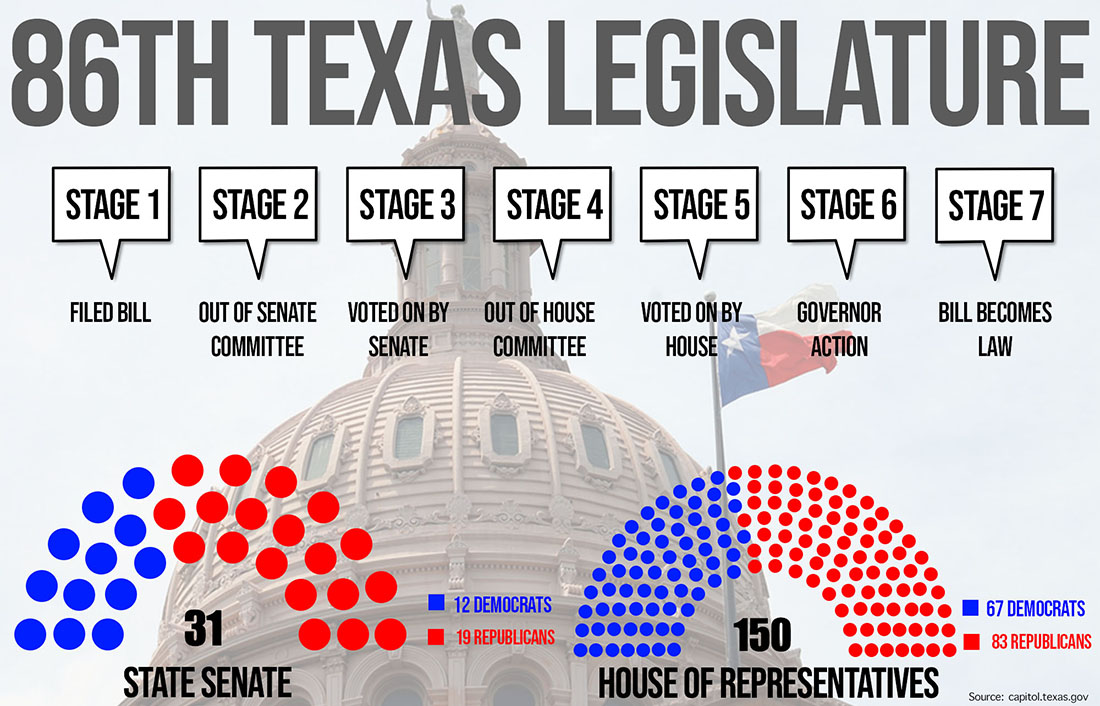
The 86th Texas Legislative Session started on Jan. 8 and with it, several bill propositions, including UTRGV joining a medical program, a study for bilingual zones and a new law school, might impact the university.
If approved, Senate Bill 134 will allow UTRGV’s School of Medicine to be part of the Joint Admission Medical Program.
The Joint Admission Medical Program is “a special program created by the Texas Legislature to support and encourage highly qualified, economically disadvantaged Texas resident students pursuing a medical education,” according to texasjamp.org.
SB 134 was filed by Texas Senators Juan “Chuy” Hinojosa (D-McAllen), Eddie Lucio Jr. (D-Brownsville) and Judith Zaffirini (D-Laredo).
Betty Monfort, senior assistant dean for admissions for the School of Medicine, said that joining JAMP will allow UTRGV to accept students that are part of the program.
“Basically … they get extra mentoring during their undergrad years,” Monfort said. “They are followed very closely. They have certain metrics that they have to maintain and certain projects that they have to do. … They hardly pay any tuition at all. They get special advice, special support during their undergrad years. They do … a summer internship and … they get stipends for, housing, food transportation and also the MCAT Prep course.”
She said the support is subsidized by generous scholarships paid for by the state.
“UTRGV is fortunate that we are going to start accepting next year,” Monfort said. “We are going to be, if the legislature approves us, which is looking very favorable, we are going to start this summer.”
Applicants from the Rio Grande Valley will benefit from this bill, as well as the community, she said.
“We need doctors for the Valley,” Monfort said. “All the analysis has shown that where students go to school and do their residency, they’re very prone to stay in that community. … Everyone benefits, all around.”
State Representative Terry Canales (D-Edinburg) filed two bills that relate to the university.
House Bill 138 plans to create a distance learning program at The University of Texas at Austin School of Law, which will allow students admitted to this institution to study from a remote facility at UTRGV during their first year of classes.
House Bill 168, also filed by Canales, relates “to a study on the creation of bilingual zones in certain areas of this state,” according to the introduced version of the bill.
Veronica Gonzales, vice president for Governmental and Community Relations, said the bill was created due to the many people from border areas that are bilingual and will bring advantages when it comes to jobs.
“I know our B3 Institute has supported it because they like the idea,” Gonzales said. “Of course, the fact that you speak two languages can have an advantage for you. … We support Representative Canales [and] his efforts and we, again, will leave it to the world of legislature and, you know, it has a long way to go.”
The study will serve to identify and evaluate Texas areas along the U.S.-Mexico border that might be designated as bilingual zones, assess the economic impact and evaluate the effect the zones would have on border and international relations.
A bilingual zone is a designated area where
— English and Spanish are both official languages.
–residents have the right to receive services from state and local governmental entities in both official languages.
–residents may be heard before the state court system in the official language of their preference.
–state and local laws are published in both languages and given equal legal weight.
–both official languages have equal status in state and local governmental employment.
A report must be submitted by the Texas Comptroller of Public Accounts containing the results of the study and recommendations for legislative or other action.
The Rider requested an interview with Canales vbut as of press time Thursday, he was unavailable.
The Texas Legislature, a bicameral system composed of the Texas State Senate and the Texas House of Representatives, holds sessions every two years on the second Tuesday of January of all odd-numbered years. Sessions take place at the Texas State Capitol in Austin and are limited to last 140 calendar days, according to ballotpedia.org.
With 19 members, the Republican Party holds the majority of the 31 seats available in the Texas Senate. The Texas House of Representatives is comprised of 150 members, currently, 83 and 67 Republican and Democrat members, respectively.
Bills can only be introduced by legislators. However, the ideas for the bills can originate from any source. These bills have to be first introduced by the legislator’s own chamber, whether it is the Texas State Senate or the Texas House of Representatives, according to The Legislative Process in Texas document published by the Texas Legislature Council.
There are seven stages bills have to go through before they become a law. The first stage is the filing of the bill in the respective chamber, which will send it to a specialized committee composed of members of the chamber. Once the committee passes the bill, it will be sent back to the chamber for approval and then to the opposite chamber, depending on where the bill originates.
After the bill has been approved by both the Senate and the House, it is sent to the governor.
“The governor has 10 days in which to sign the bill, veto it, or allow it to become law without a signature,” according to the document.






